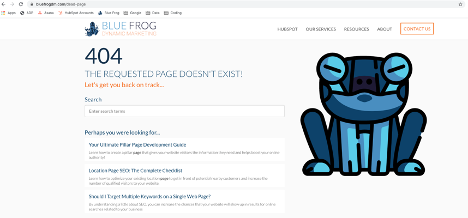
If you are considering a rebrand to your website, but fear you’ll lose all the search engine optimization (SEO) value you worked so hard to build and maintain, you’re in the right place. Rebranding can be a daunting task, and if done poorly, could significantly hurt your website’s ranking efforts. Thankfully, there are several things you can do proactively prior to, during, and after the rebrand to maintain and even boost your current website’s SEO value.
To guide you through the process, this post will cover the following:
- Auditing Your Existing Pages
- Preserving Valuable SEO Content
- Redesign on a Staging URL
- Setting Up 301 Redirects
- Notifying Google of Changes
- Post Launch Actions
- Monitoring Your Analytics
Rebrand or Relocate?
There are some instances where a rebrand is more complicated than others, for example, there are different steps you might want to take depending on if you alter your business name or URL entirely, or simply alter the design and structure of the site with the same domain. The more alterations you make in the rebranding process, the more things you need to keep in mind as you go through this process.
1. Audit Your Existing Pages
Your website’s SEO value is tied up throughout the individual pages of the site as well as the structure as a whole. However, there are outside factors to consider as well. To identify what SEO value your site currently has, and what is worth maintaining, you need to thoroughly audit your current URLs and look for high value content, any backlinks, and current rankings for each page.
Using tools like Google Search Console (GSC), you can gain insight into the following reports of your site:
- Performance: how well your domain is performing
- Sitemap: how Google is indexing your site and which pages are currently indexed
- Mobile Usability: identify any mobile usability issues per page
- Links: websites linking to your domain
For helpful tips on getting to most out of your GSC account, check out: How to Use Search Console for SEO
Note: If you are altering the name of your business during the rebranding process, you will also want to look for any mentions of your current business name, where backlinks may not be present.
All Current URLs
Even if you are not altering your site’s structure in the rebrand or redesign process, you should still be aware of all your website’s current URLs. This will allow you to set up the most efficient redirects and ensure all URLs are accounted for. You can also use this opportunity to decide if any URLs are not worth keeping. Pages that are no longer relevant to your business or provide little to no SEO value can be left out of the redirect process.
Looking through your current URLs is also the perfect opportunity to identify any duplicate content issues. Duplicate content is harmful to your website’s ranking. Should you have any duplicate webpages, keep them noted so you can add proper individual redirects to remove and resolve them.
Backlinks and Citations
One of the most important SEO values to carry through in the rebrand are backlinks. However, not all backlinks provide beneficial SEO opportunities. In some cases, backlinks can be considered toxic or manipulative in the eyes of search engines. Low quality domains providing a backlink can do more harm to your new site than you realize and should be properly disavowed before launching your new site. Disavowing tells search engines that you do not acknowledge the backlinks coming from a particular domain, so it no longer impacts your website’s SEO value.
For all good quality backlinks, it is important to note the pages they are linking to, so you can ensure those pages receive proper redirects to the new site.
Current Rankings
If you are going through a significant rebrand process that involves many changes to the content on your site, you will find it beneficial to identify the keywords that are bringing in the most traffic to your site as well as the pages with the highest keyword associations.
Using tools like SEMrush, you can quickly identify these high value keywords. While many SEO elements of your website will transfer through redirects, keywords can only be maintained if they are properly incorporated throughout the rebranded website content and meta tags.
To prioritize keywords, identify the ones your website ranks for in positions 1-20 and bring in at least some amount of monthly traffic. You can also use this audit opportunity to identify keywords you want to target more heavily in the rebrand that your current site is either ranking poorly for or not at all.
2. Preserve Valuable SEO Content
Once you have identified your highest SEO value website pages, you can use that data to determine the content that is contributing to your rankings. Along with keywords and backlinks, content is the largest contributing factor to your website’s SEO and continues to be a priority for Google search engine crawlers. Good quality content that still properly reflects your business should be preserved as much as possible. Of course, you can make structural updates to the page layout and alter the sentences as needed, but the overall topic and high-volume keywords used should be preserved and incorporated in heading tags and influential SEO elements.
Preserving content is also important for the redirect process, especially if you are making alterations to structure or layouts to pages across the site. For example, if you are combining pages, it is imperative to incorporate relevant keywords or elements related to each page for the redirects to work properly. If Google determines a redirected page is not related to the final destination page, it could potentially 404 error the page, defeating the purpose of your redirect and losing all the SEO value associated with it.
3. Redesign on Staging or Temporary URL
You should never go through a complete redesign on your existing website. This often leads to confusion for your visitors and causes more problems in the long run. The optimal approach is to build your new website in a staging portal or on a temporary URL. Once your new website is complete, you can use your redirects and publish the pages to your main website domain.
If you have difficulties determining how to redesign on a staging platform or host a temporary URL, you can always get help from a professional developer or request the assistance of a hosting company.
4. Set up 301 Redirects
Setting up your 301 redirects is the most important step of the entire rebrand and redesign process but is also an easy step to get wrong! The redirect is what will pass all current SEO equity from the original site to the new site, but you must ensure the redirects are implemented correctly and lead to relevant target pages.
To learn the ins and outs of properly setting up 301 redirects and the options available, check out this post: 301 Redirects – SEO Benefits & Best Practices
The complexity of your redirect setup depends on how many changes you make to the overall structure of your website.
No Change to Structure
If you have not altered the structure of your URLs and are simply changing the domain name, your redirect setup will be much simpler. You can essentially setup a wildcard redirect that takes all the URLs and moves them to the new domain and keeps the same structure.
Altered Site Structure
If you took the redesign process as an opportunity to improve your overall site structure, the setup of your redirects will be a little more complicated. In many cases, you will likely have to add redirects on a per page basis. While this may seem tedious and time consuming, the process can help prevent redirect errors like chains and loops.
Custom 404 Page
If there are pages you do not intend to keep on the new website and there is no other page with similar or relevant content to redirect to, it is best to not redirect it at all. A common mistake people make is to redirect all of those pages to the homepage of the new site. This practice is viewed as spammy or manipulative behavior by search engines, which generally results in both pages being dropped from the index.
To avoid this, it is best to optimize your 404 display page. A custom 404 display page provides users with other pages to access instead of a blank page. For example, Blue Frog’s 404 display provides blog post examples for the user to click on, or the option to use the navigation menu to get back to internal pages of the site.

5. Notify Google of Changes
Once your site is complete and you’ve launched your new website, you need to let search engines know, Google in particular. The best place to notify Google of your updates is Google Search Console. Depending on the changes you made, you will need to submit an updated sitemap.xml file and inform them of your domain name change.
XML Sitemap Update
The XML sitemap helps guide search engine crawlers to your more important website pages. From the redirect process, you should have a list of all the URLs on the new site. However, not every URL needs to be included in the XML sitemap file; only the most important pages that should be indexed are necessary. When you have finalized your list, use Google Search Console to submit the file to Google.
Check out this post to submit your sitemap to Google Search Console.
Domain Change
If you change your website domain entirely, you will also need to notify Google of the updated domain to ensure search results only display your new site. This does NOT apply if you are changing from http to https or www to non-www. It DOES apply if you are switching from example.com to example.org or othersite.com.
To notify Google of the new domain, use the Change of Address tool.
6. Post Launch Actions
In addition to updating your XML sitemap file in Google Search Console, there are some other actions you will want to take immediately after launching your site.
Update Directory Listings
Directory listings are important SEO elements that provide quality backlinks to your site as well as promote your business to local visitors. If you change your website domain or business name, you will need to make sure you proactively update all of your business citation information across all directories. If you are not using a listing management tool, this process can be tedious and time consuming as you will need to update each listing individually.
Updating all of your current business listings is a great opportunity to optimize current citations and find new directories to add a citation to. Check out this post for tips on optimizing your local citations: The Ultimate Guide to Local SEO Citations
Link Update Outreach
Link update outreach involves contacting the domains that provided backlinks to your site and requesting them to update the link URL. Even though you have set the proper redirects in place and those linked URLs are leading to a working new URL, it is best practice for both your site and their site to minimize how often users encounter a redirect to and from your site.
Promote Your Redesign
Promoting your newly designed website is a great way to generate more traffic and overall visibility. This is particularly important if you made significant changes to your overall design, logo, or business name.
You should communicate with those already familiar with your business through social media, email announcements, and press releases to make them aware of the alterations. You can also use PPC ads to inform users still searching for your old brand about the updates by targeting your old brand name in the campaign.
The more information and content you put out regarding the changes made to your business and website, the quicker Google and users will understand the changes and make the necessary search alterations to ensure your new brand is readily available.
7. Monitor Your Analytics
Even with all the prep work you prepared before launch, there will inevitably be errors and issues that arise post launch. Continuously monitor your websites performance and make the necessary adjustments as needed.
Crawl Errors and 404s
You may have the proper redirects set up, but should Google drop any of the redirects or your pages are not properly indexed, you will want to find and resolve them promptly. Use Google Search Console to monitor all crawling errors and implement the corresponding fixes to keep your URLs updated and available.
Traffic and Rankings
While it is expected to see some drops in traffic and rankings directly following a rebrand while search engines update their database, if you see a significant drop in traffic or rankings, you will want to take a deep dive to identify the problem. However, you can expect your rankings to steadily improve over time, especially if you continuously monitor your site’s performance and make necessary SEO updates.
The website rebranding process does not need to be overwhelming or complicated. As long as you keep the above tips in mind as you go, your new website should maintain all of the SEO value you worked so hard to earn.



